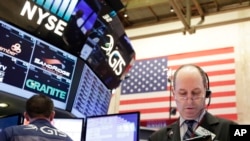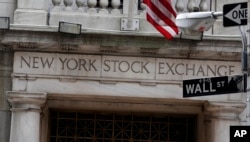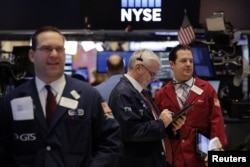Two hundred years ago on March 8, 1817, the New York Stock & Exchange Board was officially launched by a group of financial brokers, who rented rooms at 40 Wall Street.
It was renamed the New York Stock Exchange (NYSE) in 1863.
The idea for stock market was informally created in 1792, when 24 brokers and merchants signed The Buttonwood Agreement to trade securities in return for commission.
It was named for the group’s meeting place under a Buttonwood tree.
Throughout the early 1800's, the NYSE expanded beyond government bonds and bank stocks. New York City soon surpassed Philadelphia as the financial center of the United States.
Today, the NYSE is by far the world's largest stock exchange, with its listed companies valued at $19.3 trillion as of June 2016.
The average daily trading value was an estimated $169 billion in 2013. More than a billion shares are bought and sold daily by traders who work the floor of the exchange.
“The NYSE is the best example of a free, but managed, marketplace,” said VOA’s Bob Leverone, who has covered stock market for 30 years.
“The trading in individual equities is managed by designated market makers, at clear locations on the NYSE floor," added Leverone. "Those market makers have a responsibility to manage the order flow between buyers and sellers.”
From the days of handwritten, paper trading tickets that covered the floor at the NYSE, to the high speed electronic transactions of today, that market maker process has been a foundation for trading on public capital markets in the United States.
Market basics
Every Monday through Friday at 9:30 a.m. sharp, a bell rings to open the market. The closing bell rings at 4 p.m.
Buyers and sellers — or traders — bid on shares of stocks on the floor of NYSE.
Stocks are a small piece of ownership of a public corporation, and their prices usually reflect investors' opinions of what the company's earnings will be.
Traders who think the company will do well in the future bid the price up, while those who believe it will do poorly bid the price down.
Sellers try to get as much as possible for each share, trying to receive more than what they paid for it.
Buyers try to get the lowest price so that they can sell it later for a profit.
Ups and downs
1878: The first telephone is installed on the floor of the exchange, two years after. Alexander Graham Bell’s successful tests of the new technology.
1903: The NYSE moves to a new building at the corner of Broad Street and Wall Street, where it is still housed today.
1914: As World War I escalated, the NYSE closed for more than four months to stop plunging stock prices. It was the longest the NYSE has been closed.
1929: Stocks fall dramatically on Oct. 24, which became known as "Black Thursday" and is considered the start of the Great Depression.
1943: In the midst of World War II, women work on the floor of the NYSE for the first time.
1954: Dow Jones industrial average passes its 1929 peak for the first time.
1987: Dow Jones industrial average falls 22.61%, the largest one-day percentage drop.
2001: NYSE closes for four days after the Sept. 11 terrorist attacks on the World Trade Center. When it reopens, the Dow falls 684.81 points, steepest one-day point decline.
2017:The Dow Jones Industrial Average surpasses 21,000 for the first time ever.
The NYSE lists several stock market indices: the Dow Jones Industrial Average, the S&P 500, the NYSE Composite, NYSE US 100 Index, the NASDAQ Composite and others.








